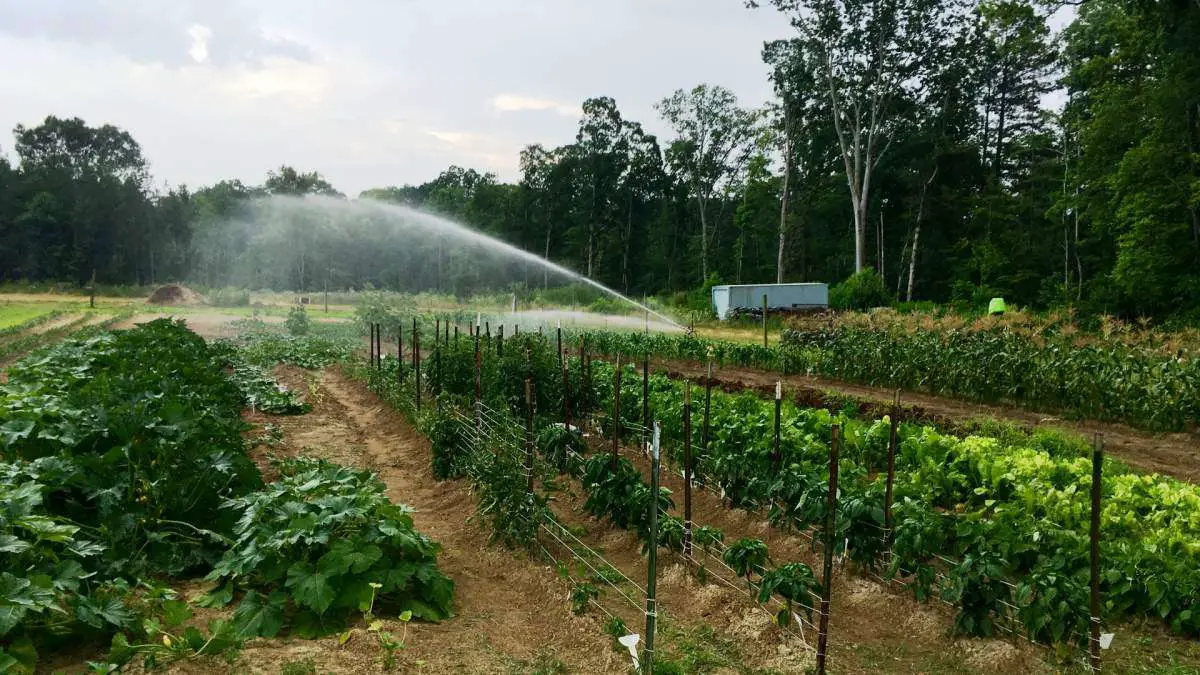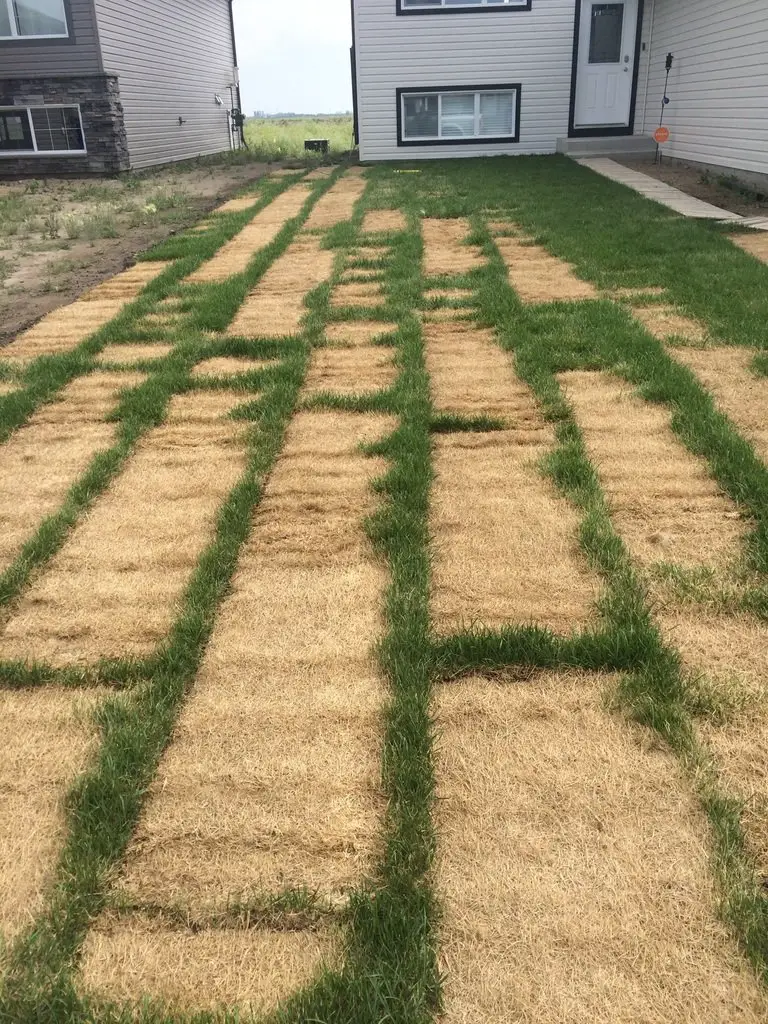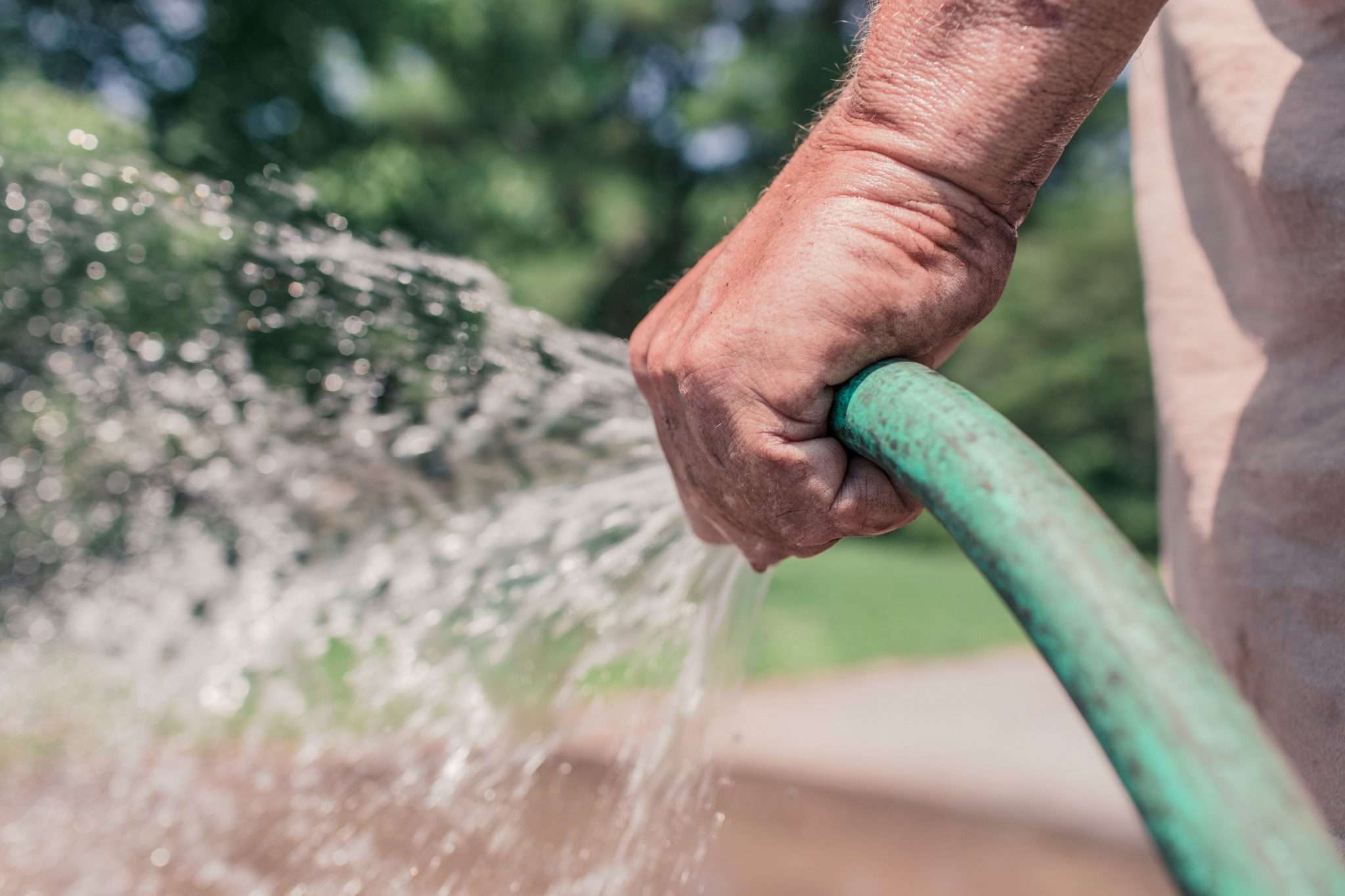How Should I Water My Lawn
In general, lawns need approximately 1 to 1½ of water per week. Our experts recommend watering grass less often and more deeply. Giving your lawn a good soaking and allowing time between waterings encourages roots to grow deeper as they seek out moisture. A robust root system allows your grass to stay greener longer and it will require less water over time.
When To Water Your Lawn
Before you even think about hitting the grass with a steady spray of water, youll want to make sure you know the best time of day to do it. Although many folks assume night time is best, most experts will tell you thats a myth.
There are a lot of people who are surprised to find out that watering your lawn at the wrong time of day can have such an impact, says Botts. Watering at night often means that water will sit on your grass overnight, which can lead to disease.
Another no-no? Watering in the hottest part of the day. Although you may think your thirsty lawn wants a drink midday, the heat will cause evaporation to happen quickly, before water has had a chance to reach the roots of your grass.
The best time of day to water is in the morning, if possible some time between 4 a.m. and 10 a.m., Botts says.
Related Video: Competing For A Gold
Over three feverish days, Bob Lilly and his team of Arboretum Foundation volunteers struggle to transform their plot inside the Washington State Convention Center into an award-winning garden. Read more.
Its totally all right to buy and plant new trees, shrubs and perennials even in the heat of summer, as long as youre willing to hand-water as often as necessary to keep the soil evenly moist to give your new treasures time to establish deep roots. Usually after a couple weeks of nurturing, new plants are able to fend for themselves, and youll be able to cut back watering to the normal schedule.
Also Check: What Will Kill Wild Violets
Leave Your Clippings In Place
Some people remove their grass clippings because it makes the lawn look cleaner. This isnt the best thing for your yard if you want to keep it healthy. Why? Your clippings will break down and provide nutrients for the soil and plants.
Some people like to mulch instead of doing this, but its really up to you. Just make sure youre not removing and tossing clippings and leaves. Your lawn and plants need them, and your city would prefer to keep these items out of a landfill!
What Happens If My Lawn Gets Too Much Water

Too much water can damage your lawn, or even your homes foundation. Grass cannot grow properly in areas with standing water or spongy soil, which allows moss to develop. You may choose to re-grade your yard, amend heavy clay soil with organic matter to improve drainage, or install a rain garden or mulch bed in low spots that frequently fill with standing water.
Also Check: Violet Killer For Lawns
Keep These Tips In Mind When Watering A Cool
- Tall fescue has a deep root system and the highest drought tolerance of all the cool-season grass types.
- Lawns that are a mixture of Kentucky bluegrass, perennial ryegrass, and fine fescues will go dormant during drought if not watered, but will revive when rain returns.
There are tons of ways to water your lawn, from sprinklers to smart watering solutions. Each has their own sets of benefits, so choose the solution that works best for you and your lawn. Below are a few methods to consider.
Pulsating sprinklers : These shoot water horizontally at a high velocity so the water isnt affected by wind.
Hose-end sprinklers: Great for small- to medium-size lawns. There are many different types, so you can choose the one that fits your lawn best.
In-ground sprinklers: These can deliver water in the most efficient pattern. Choose sprinklers that are low to the ground and use a horizontal spray pattern for best results.
Conserve When You Can
Both for the health of your lawn, and your water bill, weve got some on how to conserve water when watering your lawn. Keep automatic sprinkler systems maintained and properly set. A broken sprinkler head that shoots a stream of water into the street doesnt do anyone any good, nor does one that runs during a rainstorm. Additionally, trees can be damaged from lawn watering that leaves their trunks wet over time or does not allow their roots to stretch out and grow between waterings.
Read Also: Murray Serial Number
Lawn Care Is Hard Work
A lot of time and energy has to be invested in a lawn in order for it to receive the proper care. Here at Lawn Tech, our professional lawn care services can save you time and energy, but also provide you peace of mind. Youll be able to spend more time enjoying your yard with friends and family rather than every waking moment caring for your lawn.
Symptoms Of A Lawn That Is Under Watered
Healthy grass roots should dig about 8-12 inches deep into the soil. The soils sample above shows grass roots that are only digging 3 inches deep.
Grass growing in clumps is a clear sign of drought stress. This area of the lawn is not receiving enough water.
This lawn is suffering from a disease called Dollar Spot Fungus, a.k.a. Ascochyta Leaf Blight. This fungus only develops in lawns with shallow grass roots caused by improper lawn watering..
Also Check: Can You Hydroseed An Existing Lawn
Why Is Watering A Lawn So Important
As you know, nothing on this earth can survive without water, its the giver of life.
Its the same for your grass.
Water is the vehicle grass uses to draw nutrients from the soil. It does this through the roots and uses them during photosynthesis and the production of food.
Its also used to store sugars and carbohydrates the grass can use as food in times of need. In drought conditions or during the winter for example.
Why Is Proper Watering Important
Most living things require water to thrive, and your grass is no exception. Proper lawn watering keeps your lawn looking lush, promotes a healthy roots system, and even helps reduce the number of weeds in your lawn. With a few basic tips, you can keep your lawn watered well and avoid pitfalls from over or under-doing it.
Recommended Reading: How Much Does Lawn Maintenance Cost Per Month
Select A Sprinkler That Best Fits Your Needs
Automatic irrigation systems with pop-up sprinklers are often associated with excessive irrigation. However, properly designed and operated systems supply water uniformly over an entire area without wasted runoff.
Missouri soils generally have low water-infiltration rates. Automatic controllers can be set to supply several short cycles so that the total amount of water desired is supplied without runoff.
The most common type of watering occurs with hose-end sprinklers. Some studies have shown that the average homeowner applies 2-1/2 times the amount of water required for overgrowth when using hose-end sprinklers.
Several types of hose-end sprinklers are available . Select one that best fits the size and shape of your lawn, and operate it efficiently. All hose-end sprinklers can be attached to inexpensive timers that can be used to shut off unattended sprinklers and avoid overwatering.
Figure 1Some sprinkler types and their applications
| Sprinkler types |
|---|
Ignoring Your Grass Needs

Taking a lawns age into consideration is important. A fully-grown lawn can handle a more powerful spray, whereas newly seeded lawns need a gentler touch. If you only have a small area of newly planted seeds, a Stationary Square Sprinkler works well for gentle spot-watering, while an Adjustable Length Wind-Resistant Rectangular Sprinkler can cover a bigger area.
For a sprinkler that will grow along with the grass, try the Circular Sprinkler Spike with on/off switch. The diffuser pin allows for a customized force of spray, from a steady shower for new grass to a more powerful stream for mature lawns.
Also Check: Murray Push Mower Parts
Considering The Role Of Salt In Soil And Water
In areas of the state where water is high in salts, plant a salt-tolerant grass species, such as Seashore Paspalum, bermudagrass, or Zoysia. Water deeply but only occasionally so salt does not accumulate in the soil. High levels of sodium damage soil quality and affect the ability of water to filter through the soil. Also, salt can exacerbate the effect of drought on turfgrass. Contact your county Extension agent for more information.
The Best Lawn Watering Practices For Your Maryland Lawn
Spring means its time to think about caring for your lawn. This includes revving up that mower and getting the blades sharpened for a great cut every time. You may even want to invest in a fertilization and lawn care service as well to better the health of your yard. And proper lawn care isnt complete without correct watering.While you might think watering is something Mother Nature handles and you dont have to worry about, thats not always the case. Sometimes the queen of weather conditions doesnt come through with the water your lawn needs to thrive. Thats when you have to step in and help your lawn out. Best practices on how to water your lawn can certainly help keep your grass healthy.
Read Also: Does Grass Fertilizer Go Bad
Should I Water My Lawn Every Day
You dont need to worry about watering every day. Each week, the grass needs about an inch to an inch and a half of water. Water the lawn until the top six or eight inches of soil is wet, which will give the grass time to grow.
If you have a lawn mower, you can use it to water your lawn. You can also use a garden hose or sprinkler system to do the same thing.
Measure Water Output Using A Flow Timer
If you have a timer that measures water flow per hundred of gallons, you can take the square footage of your lawn and multiply it by 0.62 gallons to determine how many gallons your lawn needs.
This method can result in puddling, so if you notice that your lawn is having trouble absorbing the water, you can break up the overall time needed into shorter cycles. For example, take a 30-minute cycle and break it up into three 10 minute cycles placed 15 minutes apart.
Also Check: Reel Mower Sharpening Kit Ace Hardware
When Should I Water My Lawn
Timing is actually pretty essential when it comes to how to water your lawn. You want to focus on early morning watering — think pre-dawn or dawn. Why? This helps prevent evapotranspiration, which means youre losing less water to the intense sun that comes mid-day. This also saves you money on watering because each drop of water is maximized. You want to avoid watering at night because it can cause extensive disease pressure on the lawn. The combination of heat and humidity mixed with water can enhance the potential for pressure from diseases such as brown patch, dollar spot, and others.
How Can I Protect A Dormant Lawn
There are times when the weather and the local water supply are simply beyond your control. If environmental concerns, high water costs, or watering restrictions prevent you from watering your lawn as often as youd like, there are simple steps you can take to save it.
- If possible, maintain a minimal watering schedule of ½ of water every 7-14 days. Your lawn will still look brown, but will have a better chance of surviving the drought.
- A dormant, drought-stressed lawn can be easily damaged, so it is best to stay off it as much as you can.
- Once the lawn begins to receive water again, it should start to green up within 14 days some areas may need to be reseeded.
You May Like: Thistledown Herbicide
How Much And How Long To Water After Fertilizer
Watering to the appropriate levels after a fertilizer application is important. Too much and you can have run-off and diluted products. Too little and the fertilizer will just sit on the very surface of the ground and will not provide ideal conditions for the grass to take up the nutrients.
Assuming your watering schedule and amounts are set correctly for your lawn, simply resume your normal watering schedule after fertilizing. To understand how much and for how long you should be watering your lawn, check out our article on how to water your lawn.
If you have heavy clay soils or steep slopes it will be easy to accidentally create run-off water during watering cycles.
Tips On Watering A New Lawn

Have you ever planted a new lawn only to be disappointed in how it grew in? Watering a new lawn is very different from watering grass in an established lawn. Many lawns are lost at the initial watering stage. The seed will live or die depending on how you water them.
So whether you have planted seed or laid sod, lawn irrigation must be done properly for best results.
Watering a New Lawn from Seed
For the seeds to germinate, the soil needs to be consistently moist and soil temperatures must be in the right range. Germination times vary with different species, but most lawn seed will germinate within 3 to 21 days.
When watering a new lawn, the best way of keeping the seed moist is by lightly sprinkling the seeded area of the lawn at least two to three times a day. Care must be taken to ensure the soil doesn’t dry out. The seeds could perish if they are allowed to dry once the germination process has begun.
Your lawn may require more frequent watering depending on the soil type, weather, temperature, or wind. Sandy soils retain less water than loamy or clay soils. It often helps to plan seeding before several days of light rain. But don’t rely completely on the rain. Be sure to monitor it well. If the seed dries out it may be too late to save it. Covering the seed slightly with soil helps tremendously in keeping it moist.
Remember, the best time for planting cool season grasses is in the fall and warm season grasses are best planted in the spring.
Recommended Reading: Wild Violet Control In Turf
Home Lawn Watering Guide
Reviewed by Brad S. FresenburgDivision of Plant Sciences
As much as 80 percent of the water used around the home during summer is used outside. Watering the lawn is the main outside water use. During dry summers, local water authorities may cut off water for outside use or only allow watering on certain days. Both measures are necessary and effective means of reducing water use and relieving the strain on city water supplies.
To avoid severe loss of turfgrass and to conserve water, homeowners should manage their lawns each year in anticipation of water restrictions.
This guide describes that will reduce the need for irrigation while improving the competitiveness and appearance of your lawn.
How Much Water To Use
When watering an established lawn, its typically recommended to water until the top 6 to 8 inches of soil is wet. Most lawns need 1 to 1.5 inches of water per weekeither from rain or wateringto soak the soil that deeply. That amount of water can either be applied during a single watering or divided into two waterings during the week. Just be sure not to overwater your lawn.
Also Check: How To Get Rid Of Corn Speedwell In Lawn
When To Water The Lawn
If you find your lawn has taken on a grayish cast or appears to be dull green, its telling you that it needs water. You can also check your lawn by walking on it: If your footprints dont disappear quickly, its because the grass blades dont have the needed moisture to spring back. While it may seem like you can head out to water your lawn anytime during the day, your lawn actually needs more specific care. Watering in the morning is the best time for your lawn its cooler and winds tend to be calmer so water can soak into the soil and be absorbed by the grass roots before it can evaporate. If you must water in the evening, try between 4 and 6 p.m. which should give the grass blades time to dry before nightfall. The later you water, the greater chance of disease becoming prevalent in your lawn. Its worth noting, though, that you dont necessarily have to water your lawn. Lawns are resilient. Established and properly cared-for lawns can survive weeks without water by going dormant , then recover once the rain returns.
Misconception #: The Best Time To Water My Lawn Is After The Sun Sets
While weve heard a lot of people in the Lehigh Valley or Buxmont, PA area say its best to water at night, the reverse is actually true.
The ideal time to water your lawn is just after the sun rises. At this time of day, its still cool and the water wont evaporate quicklybut it still gives the grass blades plenty of time to dry before the sun sets.
Wet, dark conditions create an ideal breeding ground for causing lawn disease that can damage your turf, so watering the lawn in the evening should be avoided.
If you cant find the time to water your lawn in the early morning, even with automated timers, then try to do it early enough during the day to allow grass blades to dry by nightfall. Mid-day watering wont hurt your lawn but you may need to do it longer as youll lose moisture to evaporation.
Read Also: Murray Mower Replacement Parts
